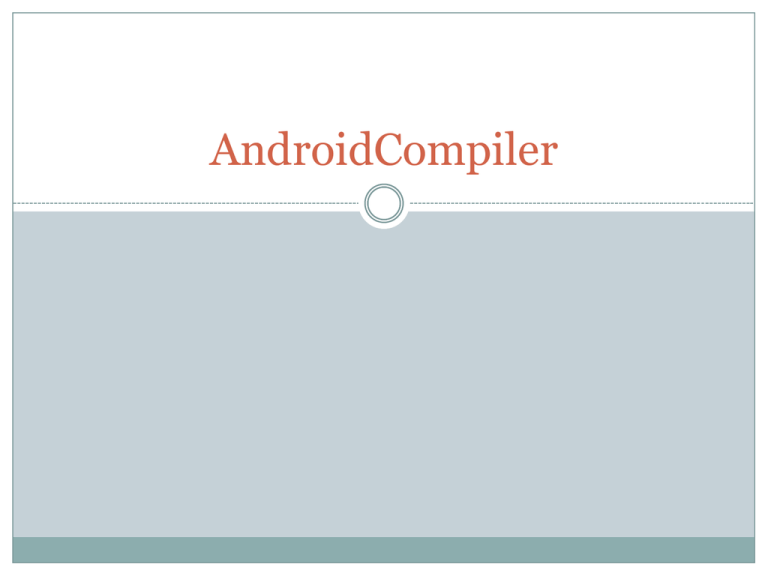AndroidCompiler
advertisement

AndroidCompiler Layout Motivation Literature Review AndroidCompiler Future Works Movtivation Android is becoming increasingly popular now Many applications deal with sensitive data such as contact number, sms messages, .. . the security of Android applications is receiving many increasing attentions we need to find a way to verify Android applications Android application Android Compiler target Model (we verify on this model) Layout Motivation Literature Review AndroidCompiler Future Works Literature Review Malware-Code Detection for Android Contextual Policy Enforcement in Android Applications with Permission Event Graphs (2012) Formal Modeling and Reasoning about the Android Security Framework (2012) Model-Checking for Verifying Android: Using Monterey Phoenix to Formalize and Verify System Architectures (2012 –NUS ) Contextual Policy Enforcement in Android Applications with Permission Event Graphs focus on detecting malicious behavior that can be characterized by the temporal order in which an application uses APIs and permissions Example: a malicious audio application: recording audio after the stopbutton pressed a normal audio application: stop recording when user pressed stop-button 2 applications use the same permissions, APIs Contextual Policy Enforcement in Android Applications with Permission Event Graphs Contextual Policy Enforcement in Android Applications with Permission Event Graphs Pegasus tool: 11626 lines of code PEG: Permission Event Graph Event Sequence: a counter example Rewirting Tool: to include runtime checks cases static analysis does not succeed Contextual Policy Enforcement in Android Applications with Permission Event Graphs Pegasus tool: Abstraction Engine: constructing PEGs from Android applications. Translation Tool : use Soot (A JAVA BYTECODE OPTIMIZATION FRAMEWORK) Verification Tool: a verification algorithm to check security properties written as Java checkers Contextual Policy Enforcement in Android Applications with Permission Event Graphs Pegasus tool – Questions? Write model-checker by themselves : strong enough? Translation from Java byte code : is exactly enough? How about illegal access to resources in Code? Could they detect? Could they deal with dynamic permission-granting? Formal Modeling and Reasoning about the Android Security Framework (2012) propose a formal model of Android OS allows one to formally state the high-level security goals They believe that their framework can accurately describe most of the security-relevant aspects of the Android OS Formal Modeling and Reasoning about the Android Security Framework (2012) Contextual Policy Enforcement in Android Applications with Permission Event Graphs Questions? Is their model totally correct? we are trying to implement their model. Using Monterey Phoenix to Formalize and Verify System Architectures (2012 –NUS ) NUS paper (2012) Monterey Phoenix (MP): an architecture description language can model system and environment behaviors based on event traces good to model Android Application A model checker for MP developed based on PAT Safety property: check if nothing bad happened: deadockfreeness, reaching Liveness property: check if something good eventually happend Using Monterey Phoenix to Formalize and Verify System Architectures (2012 –NUS ) Questions? Apply MP-model-checker for Android verification? Liveness property MP-model-checker can verify? Layout Movtivation Literature Review AndroidCompiler Future Works AndroidCompiler AndroidCompiler First goal is to use for Android programming subject at school Student source-code -> parse: verify some property automatically, get statistic information: how students design for a specific problem, … Test if the formal model in the paper “Formal Modeling and Reasoning about the Android Security Framework” correct or not AndroidCompiler Implementation: Parse AndroidManifest.xml to get configuration information: permission request, declared request, intent-binding, event handler, …. Parse *.java files to get Abstract Syntax Tree (AST) Traverse on AST to generate target-language, target-model Layout Movtivation Literature Review AndroidCompiler Future Works FutureWorks Add one more Compiler for bytecode -> target- Model try to retrieve as much information from Java /bytecode as possible: dynamic permission-granting, accessing resources illegally in code, … Applying model-checking to verify properties on target-Model PAT (NUS): already support Monterey Phoenix (MP): easy to model Android application Altarica (Labri-France): taught at PUF, similar to PAT Altarica language , Dicky’s logic (extention of CTL), Altarica model-checker



